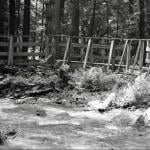Cardinal takes a crack at ‘The Da Vinci Code’
Let’s corner Dan Brown and noogie him until he tells us the truth about his book The Da Vinci Code.
Who’s with me?
I think I might have at least one joiner, if my conversation the other day with Chicago’s Cardinal Francis George was any indication.
“I resent the book, because it does undermine people’s faith,” the cardinal was telling me the other day while we were kvetching about Da Vinci. “It’s well-written, it’s persuasive, and it’s plausible,” he said. “But by the end of the book I was chewing nails.”
I read it over the Christmas holiday. The cardinal read it two months ago. And millions of other people have read it, too, since Brown’s best-selling thriller-posing-as-a-historical-novel was published last spring.
And if you haven’t read it or are in the midst of reading it, STOP READING THIS COLUMN RIGHT NOW!
It will spoil the book for you. You’ve been warned.
Anyway, back to the noogieing.
“It’s just absurd,” the cardinal continued. “If you can believe that Mary Magdalene is buried under the Louvre, somebody ought to go and call for an historical expedition. That happens in the Holy Land all the time, they have excavations. Well, let’s dig up the basement under the Louvre and see what they find.”
Now, it’s not that we, the cardinal and I, thought the book bad. It’s a great read. It took friends and colleagues about eight months to browbeat me into reading it, as my leisure-time reading choices usually run more along the lines of Tom Robbins than Tom Clancy. But once I picked up Da Vinci, I couldn’t put the darn thing down.
The cardinal, who doesn’t have time to read much popular fiction, says he read Brown’s book “for purely pastoral reasons” because so many people had read it and kept asking him questions. The last time he felt so compelled was when he was a philosophy professor more than 30 years ago and read all of Tolkien’s Lord of the Rings books because they were all his students could talk about, he said.
“It’s just a very, very enjoyable book to read, as page turners go,” George said of Da Vinci. “The trouble is, when I read it, of course, I got excited about the things I know are absurd, like Constantine invented the divinity of Christ. I mean, come on!”
See, here’s the thing about Brown’s novel: It’s a novel.
Fiction, not fact.
Or is it?
“The Priory of Sion — a European secret society founded in 1099 — is a real organization,” Brown’s novel begins on a page titled “Fact:” before the official prologue. “In 1975, Paris’s Bibliotheque Nationale discovered parchments known as Les Dossiers Secrets, identifying numerous members of the Priory of Sion, including Sir Isaac Newton, Botticelli, Victor Hugo, and Leonardo da Vinci. . .
“All descriptions of artwork, architecture, documents, and secret rituals in this novel are accurate.”
In the 454 pages that follow this caveat, Brown weaves an unbelievable story about the biggest spiritual cover-up in the history of humankind, one laced with tales of institutional misogyny, deceit, murder and general nastiness.
Here’s a brief synopsis of the plot’s theology: Jesus wasn’t divine. That’s a creation of the 4th-century church fathers. Moreover, Jesus was married to Mary Magdalene, and they had a child, whose French descendants live today, protected by a clandestine goddess-cult whose members include some of the most famous men and women of letters from the last millennium.
And the Catholic Church is hell-bent (truly) on covering it all up.
Those are the highlights.
So, what is it, Mr. Brown? Where does the fact end and the fiction begin?
It doesn’t look like we’re going to get a straight answer from the author, who is busy at home in New Hampshire working on his next book — a sequel to Da Vinci — and not giving interviews again until April, according to his Web site, www.danbrown.com.
Even when he has granted interviews, Brown’s answers to the inevitable “what’s true, what’s not” questions have been a bit sfumato, if you will.
“When you finish the book, you’ve learned a ton. I had to do an enormous amount of research,” Brown told the Philadelphia Inquirer last year. On another occasion the author said his novel was “meticulously researched and very accurate.”
Many scholars of history — religious, biblical and art — have panned Brown’s assertions. But some have said he knows from whence he speaks.
I’m no scholar of gnostic literature, or medieval art history, or “symbology,” but I’ve had some formal training and know enough about church history to be a little dangerous.
Enough to have read the New Testament gospels for myself, to know what the 325 A.D. Council of Nicea was and what happened there, and what the Knights Templar were and what they did.
Enough to know what the Gospel of Thomas, the sangreal, feminist theology, Shekinah, goddess worship, Masons, the Merovignian dynasty and Mary of Magdala are, and what they mean to religious history. Generally.
But not enough to know if the sensational specifics that Brown presents as true in his novel are really true. Which is what, around page 230, led me to wonder if I should head back for the Ph.D. I’ve been meaning to get to in order to figure out whether The Da Vinci Code is a load of horse … feathers.
Or not. Sometimes the truth is stranger than fiction.
In the meantime, happily, Cardinal George already has two doctorates. So I’ll defer to his assessment of Brown’s scholarship.
“The thing that really irked me was this list of the grand masters of a lodge that never existed,” he said, referring to Brown’s Priory of Sion. “There is a document in the Bibliotheque Nationale de Paris, where they talk about a Grand Priory of Sion, but it’s been exposed as a fraud. It would be like using the Protocols of the Elders of Zion as if it were a historical document. That’s what really irks the heck out of me.”
He’s pretty miffed.
“Jesus isn’t God but Mary Magdalene is a goddess? I mean, what does that mean? If he’s not God, why is he married to a goddess? That part, it drives me crazy. What also drives me crazy is that in the present atmosphere of extreme suspicion of the Catholic church, well you see, they covered up the sex abuse and now they’re covering up the fact that Jesus wasn’t God,” he said.
But, if Brown’s story is true, the cardinal’s in on the grand conspiracy.
“All I have to say is, nobody ever told me to keep secret the fact that Jesus was married to Mary Magdalene,” George said.
I’m inclined to believe him.
“Maybe you could start a movement to demand that we search with an archeological expedition for the bones of Mary of Magdala under the Louvre? That would really get the French excited,” the cardinal told me.
I really don’t want to get the French excited in my general direction. They seem like letter writers, I told him.
But I bet the French would be good at giving noogies.
Stay tuned as The Da Vinci Code conversation continues.
Copyright © The Sun-Times Company
All rights reserved. This material may not be published, broadcast, rewritten, or redistributed.











